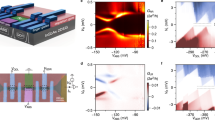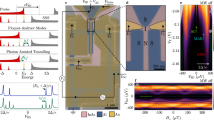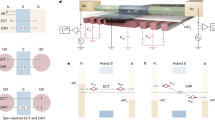Abstract
Non-locality is a fundamental property of quantum mechanics that manifests itself as correlations between spatially separated parts of a quantum system. A fundamental route for the exploration of such phenomena is the generation of Einstein–Podolsky–Rosen (EPR) pairs1 of quantum-entangled objects for the test of so-called Bell inequalities2. Whereas such experimental tests of non-locality have been successfully conducted with pairwise entangled photons, it has not yet been possible to realize an electronic analogue of it in the solid state, where spin-1/2 mobile electrons are the natural quantum objects3. The difficulty stems from the fact that electrons are immersed in a macroscopic ground state—the Fermi sea—which prevents the straightforward generation and splitting of entangled pairs of electrons on demand. A superconductor, however, could act as a source of EPR pairs of electrons, because its ground-state is composed of Cooper pairs in a spin-singlet state4. These Cooper pairs can be extracted from a superconductor by tunnelling, but, to obtain an efficient EPR source of entangled electrons, the splitting of the Cooper pairs into separate electrons has to be enforced. This can be achieved by having the electrons ‘repel’ each other by Coulomb interaction5. Controlled Cooper pair splitting can thereby be realized by coupling of the superconductor to two normal metal drain contacts by means of individually tunable quantum dots. Here we demonstrate the first experimental realization of such a tunable Cooper pair splitter, which shows a surprisingly high efficiency. Our findings open a route towards a first test of the EPR paradox and Bell inequalities in the solid state.
This is a preview of subscription content, access via your institution
Access options
Subscribe to this journal
Receive 51 print issues and online access
$199.00 per year
only $3.90 per issue
Buy this article
- Purchase on Springer Link
- Instant access to full article PDF
Prices may be subject to local taxes which are calculated during checkout




Similar content being viewed by others
References
Einstein, A., Podolsky, B. & Rosen, N. Can quantum-mechanical description of physical reality be considered complete? Phys. Rev. 47, 777–780 (1935)
Aspect, A., Grangier, P. & Roger, G. Experimental realization of Einstein-Podolsky-Rosen-Bohm gedankenexperiment—a new violation of Bell inequalities. Phys. Rev. Lett. 49, 91–94 (1982)
Loss, D. & DiVincenzo, D. P. Quantum computation with quantum dots. Phys. Rev. A 57, 120–126 (1998)
Bardeen, J., Cooper, L. N. & Schrieffer, J. R. Theory of superconductivity. Phys. Rev. 108, 1175–1204 (1957)
Recher, P., Sukhorukov, E. V. & Loss, D. Andreev tunneling, Coulomb blockade, and resonant transport of non-local spin-entangled electrons. Phys. Rev. B 63, 165314 (2001)
Loss, D. & Sukhorukov, E. V. Probing entanglement and nonlocality of electrons in a doubledot via transport and noise. Phys. Rev. Lett. 84, 1035–1038 (2000)
Crepieux, A., Guyon, R., Devillard, P. & Martin, T. Electron injection in a nanotube: noise correlations and entanglement. Phys. Rev. B 67, 205408 (2003)
Lesovik, G. B., Martin, T. & Blatter, G. Electronic entanglement in the vicinity of a superconductor. Eur. Phys. J. B 24, 287–290 (2001)
Samuelsson, P., Sukhorukov, E. V. & Büttiker, M. Orbital entanglement and violation of Bell inequalities in mesoscopic conductors. Phys. Rev. Lett. 91, 157002 (2003)
Bouchiat, V. et al. Single-walled carbon nanotube-superconductor entangler: noise correlations and Einstein–Podolsky–Rosen states. Nanotechnology 14, 77–85 (2003)
Choi, M.-S., Bruder, C. & Loss, D. Spin-dependent Josephson current through double quantum dots and measurement of entangled electron states. Phys. Rev. B 62, 13569–13572 (2000)
Recher, P. & Loss, D. Superconductor coupled to two Luttinger liquids as an entangler for electron spins. Phys. Rev. B 65, 165327 (2002)
Bena, C., Vishveshwara, S., Balents, L. & Fisher, M. P. A. Quantum entanglement in carbon nanotubes. Phys. Rev. Lett. 89, 037901 (2002)
Sauret, O., Feinberg, D. & Martin, T. Quantum master equations for the superconductor-quantum dot entangler. Phys. Rev. B 70, 245313 (2004)
Torres, J. & Martin, T. Positive and negative Hanbury-Brown and Twiss correlations in normal metal-superconducting devices. Eur. Phys. J. B 12, 319–322 (1999)
Falci, G., Feinberg, D. & Hekking, F. W. J. Correlated tunneling into a superconductor in a multiprobe hybrid structure. Europhys. Lett. 54, 255–261 (2001)
Samuelsson, P. & Büttiker, M. Chaotic dot-superconductor analog of the Hanbury Brown–Twiss effect. Phys. Rev. Lett. 89, 046601 (2002)
Deutscher, G. Crossed Andreev reflections. J. Supercond. 15, 43–47 (2002)
Morten, J. P., Brataas, A. & Belzig, W. Circuit theory of crossed Andreev reflection. Phys. Rev. B 74, 214510 (2006)
Golubev, D. S. & Zaikin, A. D. Non-local Andreev reflection in superconducting quantum dots. Phys. Rev. B 76, 184510 (2007)
Beckmann, D., Weber, H. B. & v Löhneysen, H. Evidence for crossed Andreev reflection in superconductor-ferromagnet hybrid structures. Phys. Rev. Lett. 93, 197003 (2004)
Russo, S., Kruog, M., Klapwijk, T. M. & Morpurgo, A. F. Experimental observation of bias-dependent nonlocal Andreev reflection. Phys. Rev. Lett. 95, 027002 (2005)
Bjork, M. T. et al. Few-electron quantum dots in nanowires. Nano Lett. 4, 1621–1625 (2004)
Fasth, C., Fuhrer, A., Bjork, M. T. & Samuelson, L. Tunable double quantum dots in InAs nanowires defined by local gate electrodes. Nano Lett. 5, 1487–1490 (2005)
Csonka, S. et al. Giant fluctuations and gate control of the g-factor in InAs nanowire quantum dots. Nano Lett. 8, 3932–3935 (2008)
Feinberg, D. Andreev scattering and cotunneling between two superconductor-normal metal interfaces: the dirty limit. Eur. Phys. J. B 36, 419–422 (2003)
Kurtsiefer, C., Oberparleiter, M. & Weinfurter, H. High-efficiency entangled photon pair collection in type-II parametric fluorescence. Phys. Rev. A 64, 023802 (2001)
Burkard, G., Loss, D. & Sukhorukov, E. V. Noise of entangled electrons: bunching and antibunching. Phys. Rev. B 61, R163003 (2000)
Chtchelkatchev, N. M., Blatter, G., Lesovik, G. B. & Martin, T. Bell inequalities and entanglement in solid-state devices. Phys. Rev. B 66, 161320 (2002)
Samuelsson, P., Sukhorukov, E. V. & Büttiker, M. Electric current noise of a beamsplitter as a test of spin entanglement. Phys. Rev. B 70, 115330 (2004)
Herrmann, L. G. et al. Carbon nanotubes as Cooper pair beam splitters. Preprint at 〈http://arxiv.org/abs/0909.3243v1〉 (2009)
Acknowledgements
We thank G. Zaránd, P. Moca and C. W. J. Beenakker for discussions, and C. B. Srensen and M. Aagesen for Molecular Beam Epitaxy growth. This work was supported by the Swiss National Science Foundation, the Swiss National Center of Competence in Research on Nanoscale Science, the Danish Natural Science Research Council, Hungarian Scientific Research Fund (OTKA) project NNF 78842 and Marie Curie project 41139 of the European Union. S.C. is a grantee of the Bolyai János Scholarship.
Author Contributions L.H. and S.C. fabricated the samples and performed the measurements. The idea was born of discussions between C.S., S.C. and L.H. InAs nanowires were grown in the laboratory of J.N. All authors were involved in interpretation, discussion and paper writing.
Author information
Authors and Affiliations
Corresponding authors
Supplementary information
Supplementary Information
This file contains Supplementary Methods, Supplementary Figures S1-S3 and Supplementary References. (PDF 467 kb)
Rights and permissions
About this article
Cite this article
Hofstetter, L., Csonka, S., Nygård, J. et al. Cooper pair splitter realized in a two-quantum-dot Y-junction. Nature 461, 960–963 (2009). https://doi.org/10.1038/nature08432
Received:
Accepted:
Issue Date:
DOI: https://doi.org/10.1038/nature08432
This article is cited by
-
Correlation between two distant quasiparticles in separate superconducting islands mediated by a single spin
Nature Communications (2024)
-
Triplet correlations in Cooper pair splitters realized in a two-dimensional electron gas
Nature Communications (2023)
-
Spin effects on transport and zero-bias anomaly in a hybrid Majorana wire-quantum dot system
Scientific Reports (2023)
-
Majorana zero modes in Y-shape interacting Kitaev wires
npj Quantum Materials (2023)
-
Cryogenic multiplexing using selective area grown nanowires
Nature Communications (2023)
Comments
By submitting a comment you agree to abide by our Terms and Community Guidelines. If you find something abusive or that does not comply with our terms or guidelines please flag it as inappropriate.



